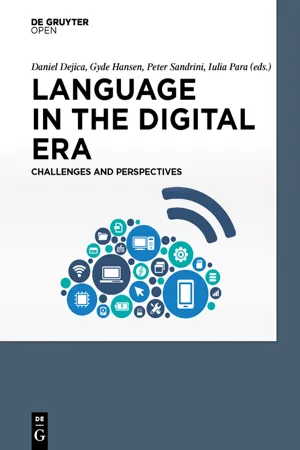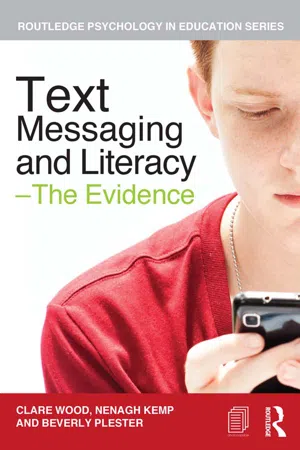Languages & Linguistics
Text Speak
Text speak refers to the use of abbreviations, acronyms, and other shorthand forms of language commonly used in text messaging and online communication. It is often characterized by its brevity and informality, and has become a widely accepted form of communication in many contexts. However, it is also criticized for its potential to undermine traditional language skills and communication norms.
Written by Perlego with AI-assistance
Related key terms
1 of 4
Related key terms
1 of 3
4 Key excerpts on "Text Speak"
- eBook - ePub
- Jean D. M. Underwood, Lee Farrington-Flint(Authors)
- 2014(Publication Date)
- Wiley-Blackwell(Publisher)
This sheer increase in text messaging is also having a profound effect on learner’s written language skills. As it is now widely recognized, text messaging has evolved as a new language, often seen as a hybrid between traditional forms of written and spoken English because of its representation of features often found in spoken language. This new form of abbreviated messaging is commonly referred to by many as Text Speak or textisms (Wood, Kemp, & Plester, 2013). Changes to the structure of written language come out of necessity as a result of the limitations imposed by the technology itself. For example, with Twitter, a 140-character limit is imposed for any individual tweet while for text messages these were originally constrained to 160 characters per text. This meant that individuals needed to find a more efficient and cost-effective way of communicating as much information as possible within the shortest space available.Showing some similarities to speech, text abbreviations are spontaneous, loosely structured and focus on the invention of new spelling–sound patterns. Many of these abbreviations, despite deviating from the grammatical structure found within traditional written forms of English, do share many similar features with the phonological aspects of speech. For example, common abbreviations can include letter/number homophones (gr8 for great or 2day for today), phonological contractions (txt for text), non-conventional spellings (foned, nite for phoned and night), shortenings (Uni, poss), G clippings - Daniel Dejica, Gyde Hansen, Peter Sandrini, Iulia Para(Authors)
- 2024(Publication Date)
- De Gruyter Open Poland(Publisher)
Netspeak refers to speaking in ways commonly used to converse in text on the Internet. According to macmillandictionary.com, netspeak is ‘the special language, abbreviations, and expressions used by people when communicating using the Internet’. Netspeak, or the Internet language is ‘written speech’ (Elmer–Dewitt 1994), while Davis and Brewer (1997:2), quoted by David Crystal (2006:27) say that ‘electronic discourse is writing that very often reads as if it were being spoken – that is as if the sender were writing talking’ (Crystal, 2006:27). Some of the newly invented words belonging to netspeak are already included in the Oxford Dictionary of New Words 1997 (e.g. e-text, e-zine, e-cash, e-money). Other words are not yet included in this dictionary still, but we can come across them in online communication: e-lancers, e-management, e-government, e-books, e-voting, e-newsletter, e-cards, e-shop. The number of these new words that will still be in use in the future is impossible to predict, as language changes all the time. Netspeak – the type of language used on the Internet, displays some characteristic features which make it different from the traditional correct language; these features can be noticed if we study pieces of writing in online communication and are due to their electronic, global, and interactive character. Netspeak is mainly used on social media websites, online messengers, sms and very often in informal short e-mails. It is a code consisting of simpler or modified spelling of words in order to avoid wasting time while typing a message (texting). Messages are usually written as if someone were really talking (as mentioned in the two previous definitions), and might, therefore, not have the correct grammar or punctuation that formal writing should have (e.g., Marry: hey, bff how you doin? // Jane: im ok bff- eBook - ePub
- Clare Wood, Nenagh Kemp, Beverly Plester(Authors)
- 2013(Publication Date)
- Routledge(Publisher)
yes!!! ) seems to be slightly increasing (from 3.6, to 4.3, to 5.7, to 5.7 per cent of all textisms, across the four years). This will be something to observe as the message hardware (keyboard type) and software (entry system) continue to evolve.One factor that has been largely overlooked is that differences in tex-tism use might depend heavily on young adults' motivation to compose text messages in ‘correct’ English (or other language), regardless of their conventional literacy skills. There is no requirement that text messages follow the conventional rules of writing and, despite the existence of various glossaries of textspeak, there is no standard way that words should be abbreviated. Many texters may feel that being efficient (in terms of time or effort taken to compose a message) is more important than the use of conventional spelling and grammar, when the main aim is communication. The desire for efficiency may cut across differences in conventional literacy skills, leading to the rather messy picture that we have seen about any links between textism use and literacy scores. Of course, this efficiency is two-fold: there is no point saving time writing a message so abbreviated that the reader cannot decipher it (see Kemp, 2010). But as long as both sender and receiver share an understanding of the types of textisms that might be used, it makes sense that the use of textisms might depend as much on a person's desire to get their message across with the minimum amount of time and effort as on their conventional literacy skills.People's desire to spell text messages ‘correctly’ is unlikely to be all-or-none. Despite the concerns of the media, there is evidence that young adults are generally aware of when it is appropriate to use textisms and when it is not. This sense of register is seen in studies in which young people have been asked what they think of the use of textisms in various types of messages. Drouin and Davis (2009) found that while 75 per cent of their undergraduate participants believed it to be appropriate to use textisms in a message to a friend, only 6 per cent thought it appropriate to use them in a message to a university instructor. There is social meaning in these opinions; Lewandowski and Harrington (2006) report that undergraduates were more likely to perceive the writers of formal emails to be lacking in skill or effort if the writers included textisms in these emails than if they did not. Grace et al. (submitted, a) found that undergraduates thought it more appropriate to use textisms in contexts that were informal or to recipients who were socially close (such as a friend) than in contexts that were formal or to more socially-distant recipients (such as a lecturer). - Vivian Cook, Des Ryan, Vivian Cook, Des Ryan, Vivian Cook, Des Ryan(Authors)
- 2016(Publication Date)
- Routledge(Publisher)
Writing about the emergence of nationalism and the modern European nation state, Benedict Anderson argued that the state was an imaginary construct (1991: 50) which had been relayed, reinforced and reified by the assistance of the processes he termed ‘print capitalism’ (1991: 52, 54). The ideological and material procedures of print production – censorship, lexicons of legitimated usage, stylesheets, proofreading, compositors’ typesetting – had supplanted a medieval world of supranational written discourse conducted in manuscripts written in book Latin; it had removed the written representation of regiolectal practices and other localised sites of variation. Texting and other messaging presage a different age of globalised, virtual distribution of self-published interactive writing, which has reinscribed local and global resources in a manner of socially proximate, conceptually spoken, geographically remote, self-published interaction. These forms of perpetually iterated, digitally mediated vernacular writing are enabled by the service providers of texting and messaging platforms: often funded by globalised private capital which operates outside the circumscriptions of any single nation state. In short, the socioeconomic and material conditions associated with the broadcasts of print literacy continue to be singularly influential but they no longer operate as a representational hegemony.By this interpretation, texting and other messaging represent forms of linguistic and graphical ‘code-meshing’ occurring at a sociohistorical moment of ‘post-standardisation’, as argued by Androutsopoulos (2011), in which there is a shift from the comparatively static lexicon of authorised written forms, as manifest in the fixity of print production conventions, to ephemeral co-constructions of graphically-made social meaning. This context extends more widely than the configuration of communicative resources used in SMS or messaging, or in CMC more generally, reflecting the impact of accelerating globalised flows of people, money and digitally mediated semiotic resources (Pennycook 2003, 2007, 2010; Blommaert 2008, 2010). The consequence is that the standardised English written system has been resituated as an ideological construct achieved by the representational exclusion of the sociohistorical, socioeconomic, material processes by which that system was arrived at. As Irvine and Gal have observed,
Index pages curate the most relevant extracts from our library of academic textbooks. They’ve been created using an in-house natural language model (NLM), each adding context and meaning to key research topics.
Explore more topic indexes
Explore more topic indexes
1 of 6
Explore more topic indexes
1 of 4



